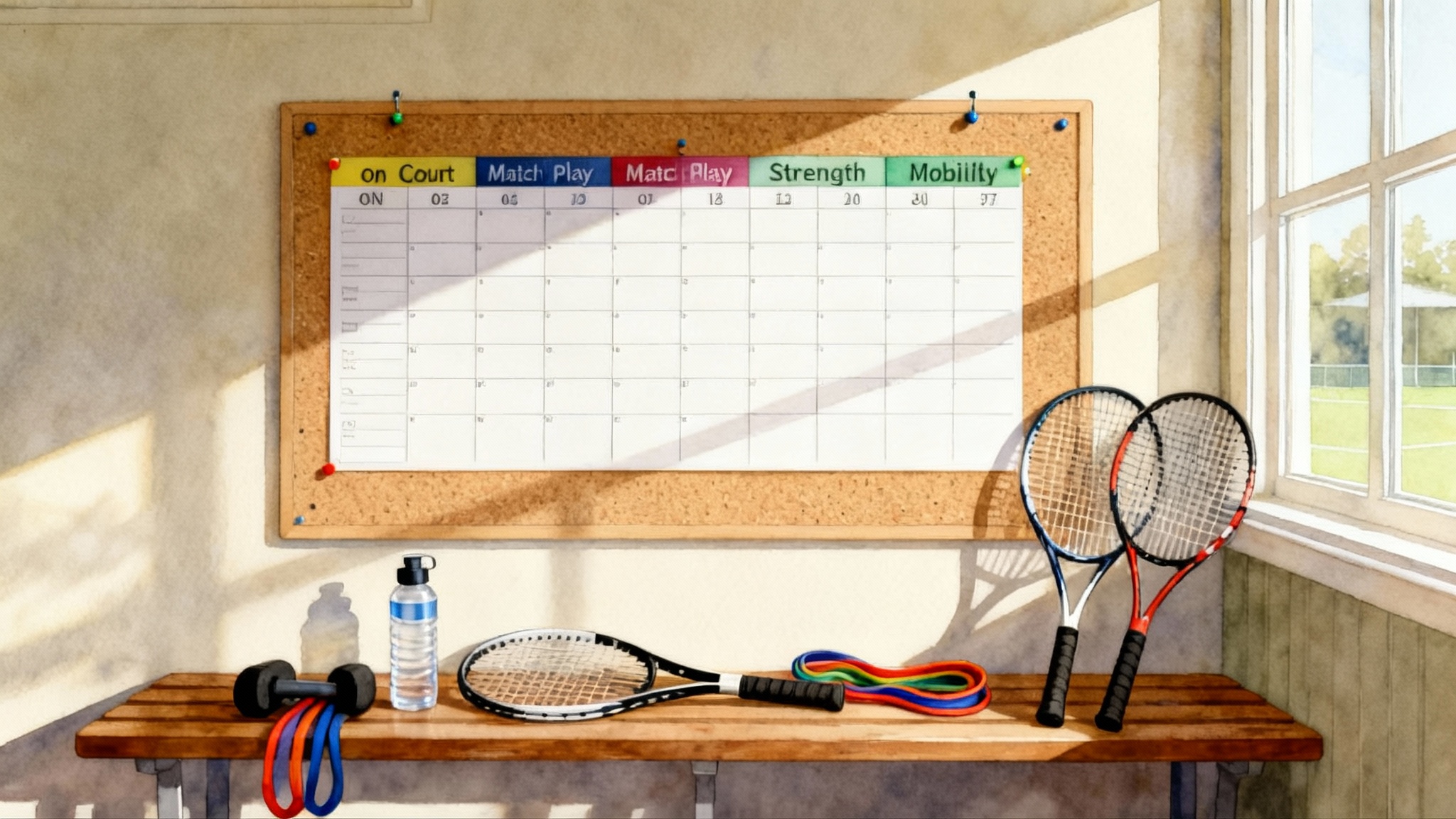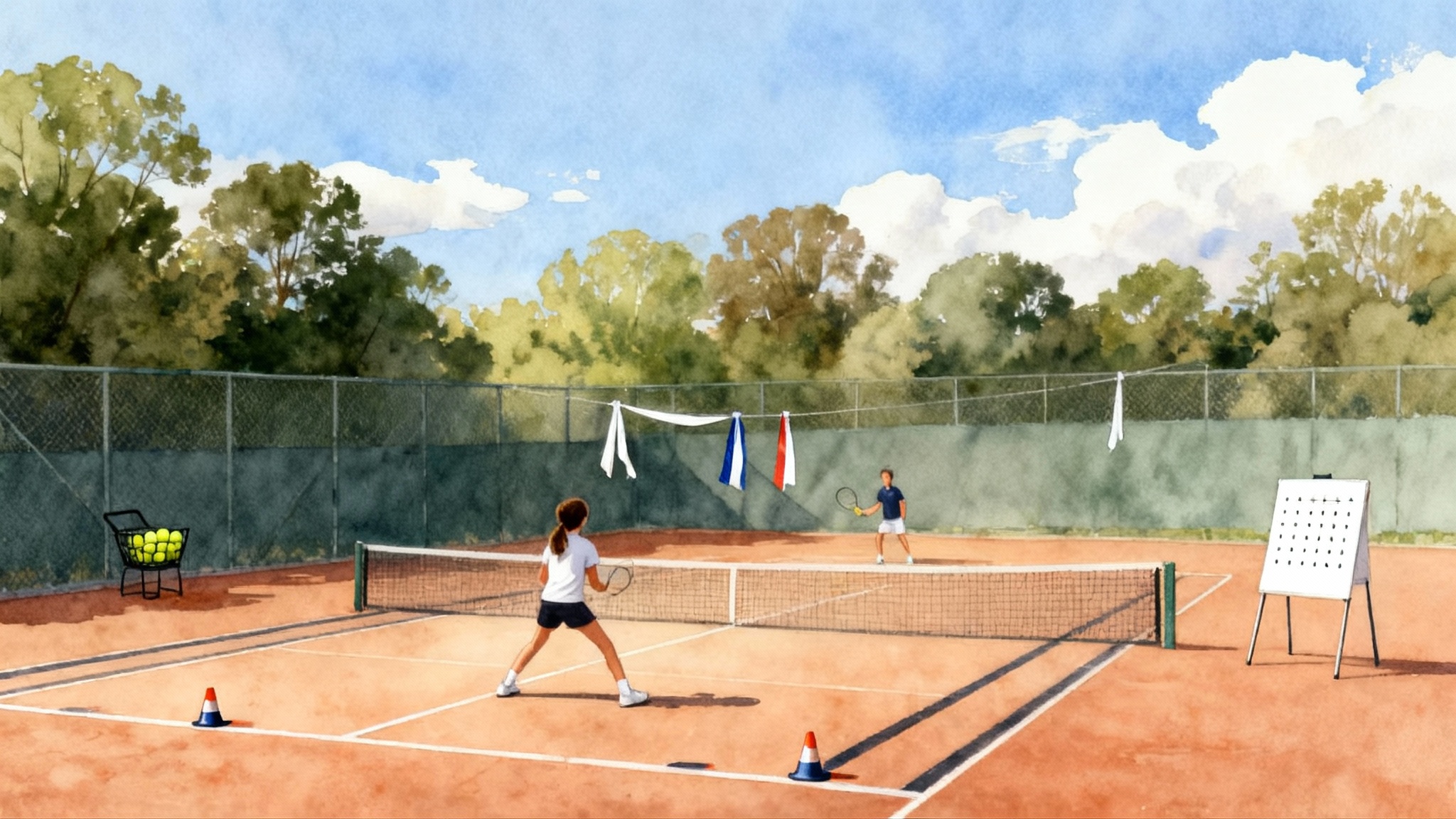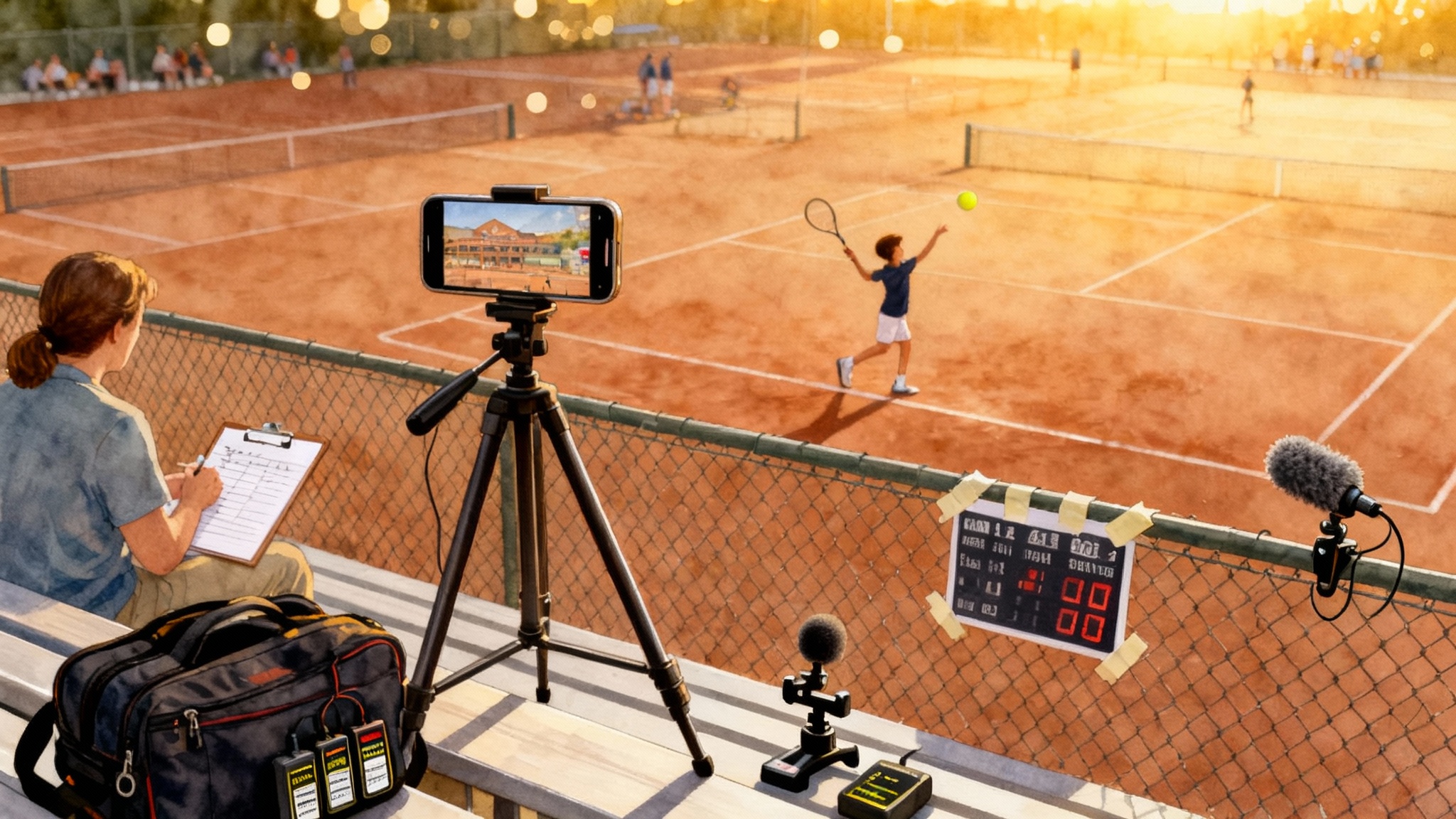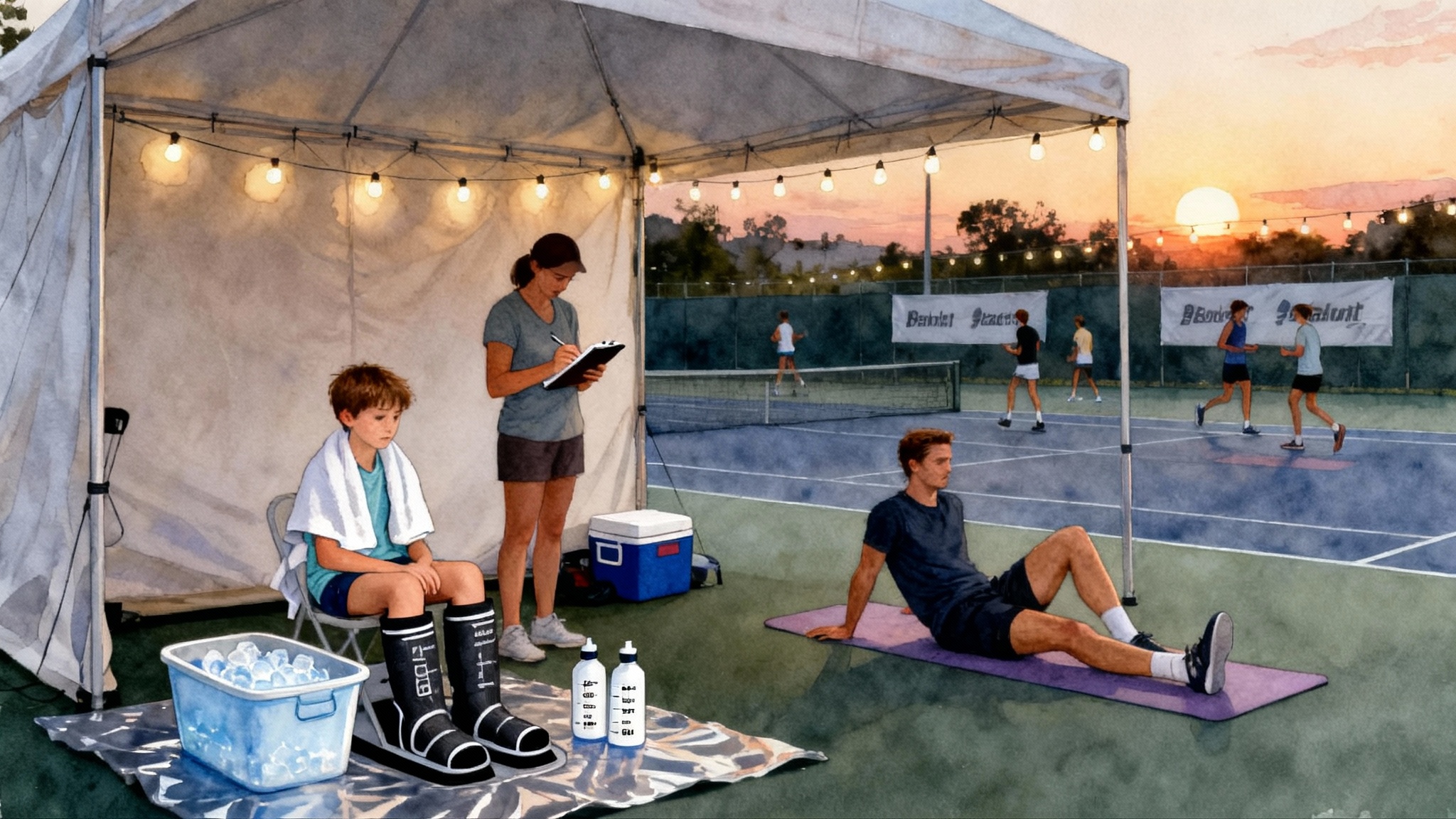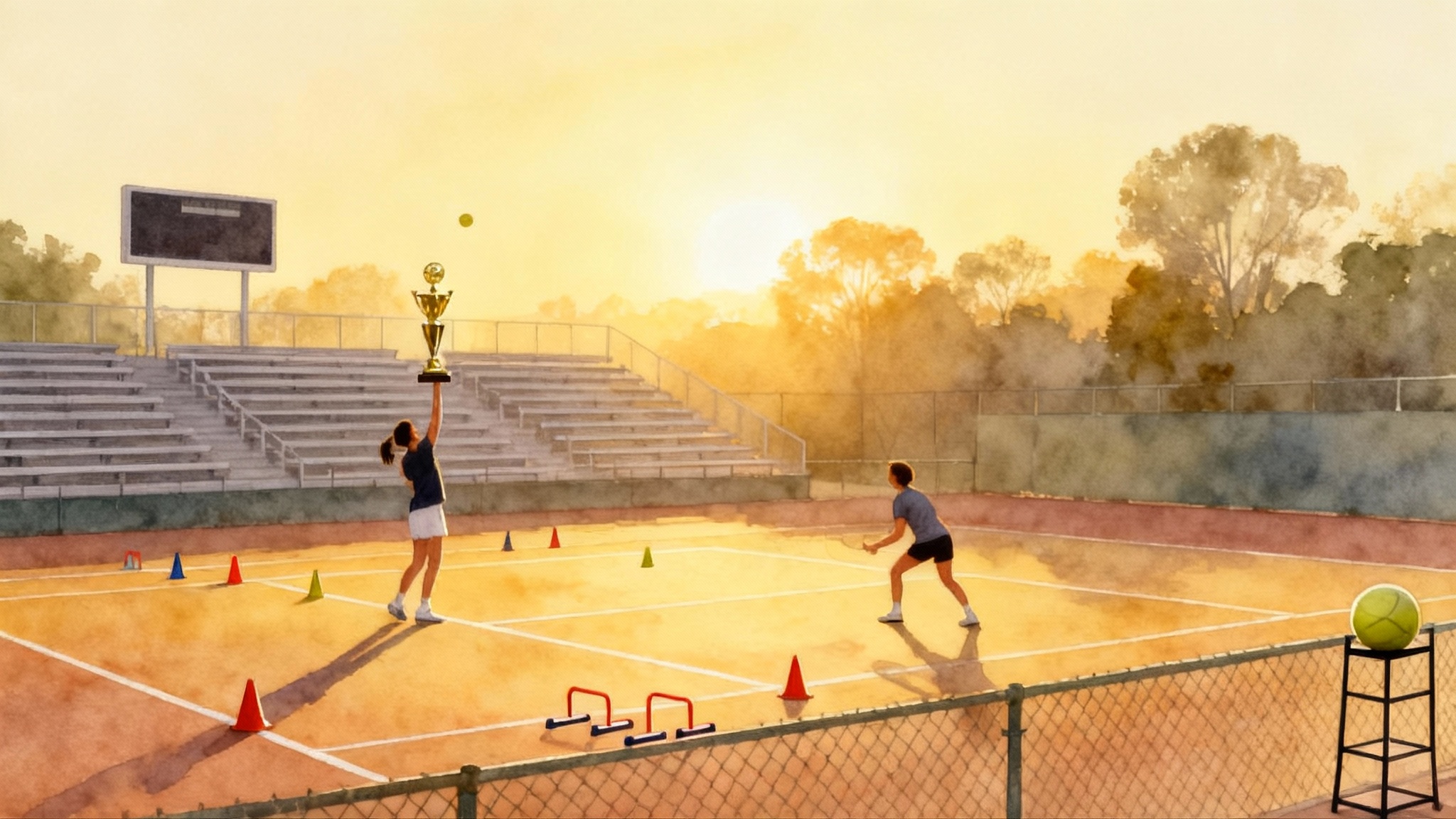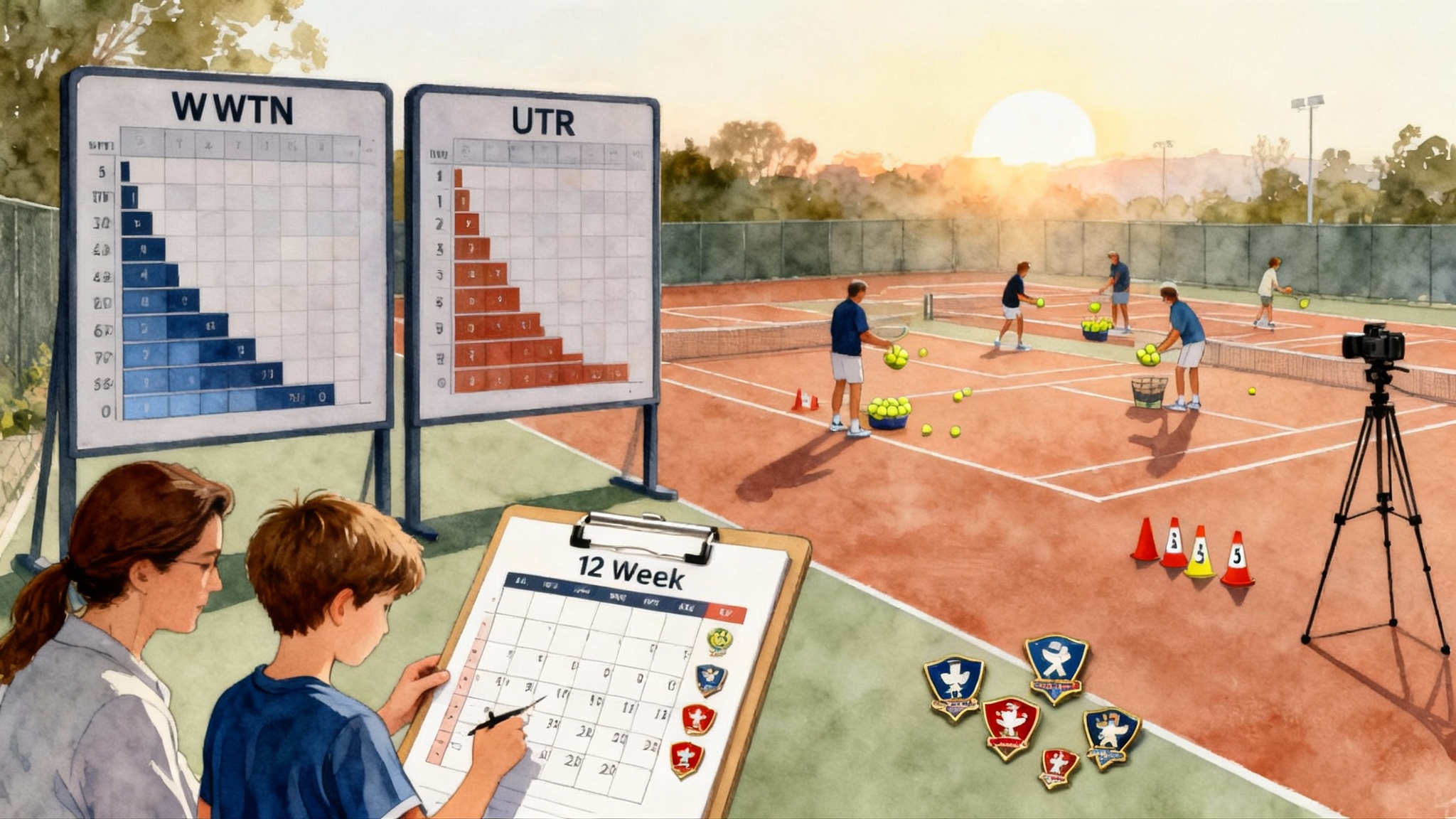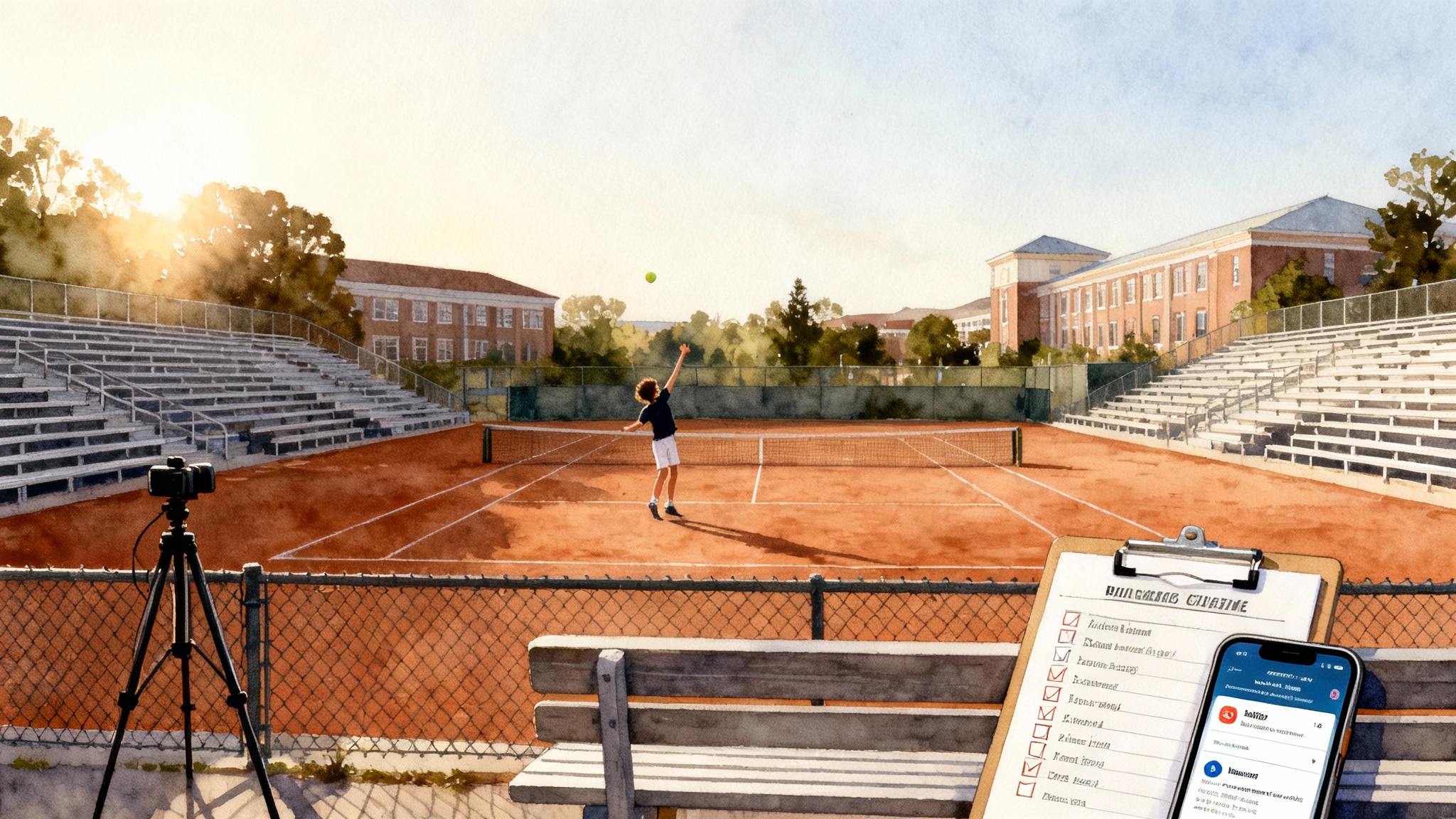Peak Height Velocity in Junior Tennis: A Parent’s Guide
Your child hits a growth spurt, tennis loads spike, and injuries lurk. Learn how to measure peak height velocity at home, adjust weekly training, and use a clear traffic-light plan to stay healthy from ages 9 to 16.

Why growth spurts are the hidden pivot in junior tennis
If your child suddenly looks taller in team photos, you are not imagining it. Between ages 9 and 16, bones can lengthen faster than muscles and tendons can adapt. This surge is called peak height velocity, the period when a child’s growth rate is at its fastest. Tennis rewards speed, reach, and leverage, yet those same advantages can turn into risk when levers get longer overnight and coordination temporarily dips.
This guide gives families a practical, evidence‑minded roadmap. You will learn how to measure peak height velocity at home, how to cap weekly training loads, which strength methods are safest during a growth spurt, how to tweak footwork and strokes, what injury warning signs to watch for, and how to schedule tournaments without burying a young athlete. For broader context on appropriate volume, see our weekly tennis plans by age.
Measure peak height velocity at home in 10 minutes per week
You do not need a lab. You need consistency, a wall, a book, a chair, and a scale.
- Tools
- A flat wall and masking tape to mark height
- A hardcover book to level the head
- A dining chair and a sturdy book for sitting height
- A reliable bathroom scale
- A notebook or spreadsheet
- Standing height
- Shoes off, heels and back against the wall, look straight ahead.
- Place the book flat on the head, slide to the wall, mark, and measure to the nearest millimeter.
- Sitting height
- Sit tall on the chair with feet flat, no slouching.
- Place the book on the head, mark the wall, and measure again. Subtract chair height if needed to get true sitting height.
- Body mass
- Weigh once a week, first thing in the morning, wearing similar clothing.
- Frequency
- Measure height once per week, same morning, same routine. Put the numbers into a simple chart.
- Spotting the surge
- Calculate weekly growth as centimeters gained. Convert to a yearly rate by multiplying by 52.
- When the rolling 4‑week rate accelerates toward seven to eight centimeters per year and stays there for several weeks, your child is near peak height velocity. Most girls hit the fastest rate between about 10 and 13 years, most boys between about 12 and 15 years, but the real signal is the rate on your chart, not the birthday on the cake.
This approach is deliberately simple. Families who want more precision can add sitting height and leg length to estimate “maturity offset,” but for training decisions a steady weekly chart plus honest soreness tracking is usually enough to guide safe adjustments.
The PHV traffic light: know the flags and what to do
Peak height velocity, or PHV, can make normal training feel different. Use this traffic‑light system to respond early and confidently.
Green: train as planned
- Mild, symmetrical muscle soreness under 24 hours
- No limp, no morning stiffness beyond 15 minutes
- No focal tenderness at the heel or just below the kneecap
- Energy, mood, and appetite steady
Yellow: adjust within 48 hours
- Heel pain that fades with warm up, classic for Sever’s disease in growing heels
- Tender bump below the kneecap that aches after jumping or serving, common in Osgood‑Schlatter disease
- One‑sided shin or hip soreness that lingers past 24 hours
- Clumsier footwork than usual, repeated misjudged distances, unusual fatigue
Actions for yellow:
- Reduce jump and sprint counts by 30 to 50 percent for two to three sessions.
- Swap one high‑impact session for a technique and mobility session.
- Shift strength work to isometrics and slow eccentrics for the irritated area.
- Recheck in 48 hours; if no improvement, treat as red.
Red: stop impact and seek evaluation
- Limping or pain at rest
- Night pain that wakes the athlete
- Sharp, localized bone pain, especially in the back, hip, shin, or foot
- Back pain with leg weakness, tingling, or changes in bowel or bladder control
Actions for red:
- Stop running, jumping, and serving that day.
- Consult a qualified clinician. Respect full rest from impact until cleared.
Weekly load caps during rapid growth
During the PHV window, the bones grow fast, the tendons lag, and control is catching up. Keep the athlete learning and enjoying tennis, but put thoughtful ceilings on load.
Simple caps for 9 to 12 years during PHV weeks
- Total organized sport time: 8 to 10 hours across all sports
- Tennis sessions: 3 to 4 on‑court sessions, 60 to 75 minutes
- Practice serves: 40 to 60 per session, 120 to 180 per week
- Max matches: 1 per week, or 2 if short format
- Jumps and sprints combined: about 60 to 100 contacts per session, one higher day and one lower day
Simple caps for 13 to 16 years during PHV weeks
- Total organized sport time: 10 to 14 hours across all sports
- Tennis sessions: 4 to 5 on‑court sessions, 75 to 90 minutes
- Practice serves: 60 to 80 per session, 160 to 220 per week
- Max matches: 1 to 2 per week, separated by at least 48 hours
- Jumps and sprints combined: 80 to 130 contacts per session, one high, one medium, one low
Session rating of perceived exertion, or RPE, anchors these caps. Ask the athlete to rate each session from 1 to 10. Multiply that number by minutes trained to get a simple training load. Across the PHV weeks, increase or decrease total weekly load by no more than about ten to fifteen percent, and schedule at least one full rest day.
Safe strength blocks: isometrics and eccentrics
Strength keeps tendons resilient and timing sharp, but the plan needs to fit the biology of a growing frame. During PHV, favor isometrics and slow eccentrics that load tissues without explosive spikes.
Lower body
- Spanish squat isometric, 4 sets of 30 to 45 seconds, rest 60 seconds. Great for patellar tendon irritation below the kneecap.
- Heel raise isometric on two legs, 5 sets of 30 seconds at mid‑height, rest 45 seconds, progress to single leg as tolerated. Useful for Achilles and Sever’s disease.
- Split squat, 3 sets of 6 slow eccentric reps, 5 seconds down, 2 seconds up, light to moderate load.
- Nordic hamstring assisted, 3 sets of 4 to 6 controlled reps, slow lower, push up with hands as needed.
Trunk and hips
- Side plank and front plank variations, 3 sets of 20 to 40 seconds each, focus on breathing.
- Tall‑kneeling anti‑rotation press with band, 3 sets of 8 to 12 reps, 3 seconds out, 3 seconds in.
- Hip airplane or supported single‑leg hinge, 3 sets of 6 reps, slow control.
Shoulder and scapula
- Wall slides and Y‑T‑W raises, 2 to 3 sets of 8 to 12 reps.
- External rotation with a band at 30 to 45 degrees of abduction, 3 sets of 10 reps, 3 seconds out, 3 seconds in.
Rules of thumb
- If pain rises above 3 out of 10 during an exercise, switch to an easier variation or hold instead of reps.
- Keep total strength time to 20 to 30 minutes on tennis days during PHV, up to 40 minutes on non‑tennis days.
- Prioritize quality of movement, steady breathing, and slow lowering phases.
Footwork and stroke tweaks while bones get longer
When levers change, technique that felt automatic can feel new again. Small adjustments prevent overload while coordination recalibrates.
Serve
- Lower the toss slightly, to a peak only a few inches above a comfortable, fully extended reach. This reduces lumbar extension demands and helps timing.
- Use a taller starting stance and a smoother knee bend, avoid deep dips if the patellar tendon is irritated.
- Cap practice serves and add two sets of 30‑second forearm and wrist isometrics on heavy days.
Forehand and backhand
- If the wrist or elbow is sore, soften setup by easing an extreme western forehand toward a semi‑western, and avoid late, outside‑contact swings.
- Keep the backhand contact comfortably in front of the hip. For a two‑handed backhand with ulnar‑sided wrist soreness, try a slightly more neutral top‑hand grip.
Lunge and split‑step
- During PHV, reduce lunge depth so the front thigh hits about parallel, not deep knee angles. Add more small adjustment steps instead of single big reaches.
- Make the split‑step a gentle unweighting, not a jump. If timing is off, use split‑step timing made simple to reset quickly.
Equipment and surfaces
- Use a slightly softer string setup or lower tension by two to three kilograms to cut shock.
- Consider a small heel lift in everyday shoes, five to eight millimeters, if the Achilles or heel is irritated.
- Favor training on clay during PHV weeks when possible to reduce peak loads.
A practical 4‑week microcycle template
Below is a template you can scale up or down. The version shown fits an athlete in the middle of PHV. Pre‑ and post‑PHV notes follow each week.
Week 1: Establish rhythm
- Mon: On‑court 75 min, low to moderate intensity. Serve mechanics with reduced toss, forehand timing, split‑step rhythm. Strength 20 min, isometrics focus.
- Tue: Off‑court 40 min. Mobility for hips and ankles, trunk isometrics, breathing. Optional easy bike 15 min.
- Wed: On‑court 75 to 90 min, moderate. Pattern play to corners with shorter points. Cap sprints at 8 to 10 efforts of 10 to 15 meters.
- Thu: Rest or walk and stretch 20 min.
- Fri: On‑court 75 min, moderate. Serve plus first ball, point starts only, cap total practice serves at 60.
- Sat: Match play or set play 60 to 90 min, stop at first sign of yellow flag symptoms.
- Sun: Rest.
Pre‑PHV: You may add 10 to 15 percent volume on Mon and Fri and extend strength work to 30 minutes.
Post‑PHV: Add mild plyometrics, 3 sets of 6 to 8 low pogo jumps and low lateral bounds, if pain free.
Week 2: Load slightly, protect tendons
- Mon: On‑court 90 min, moderate. Footwork ladders for rhythm, then live rally constraints to deep middle. Strength 25 min with slow eccentrics.
- Tue: Off‑court 35 min. Calf and quadriceps isometrics, trunk anti‑rotation.
- Wed: On‑court 75 min, light. Technique day, video a few serves and forehands to check toss height and contact.
- Thu: Rest.
- Fri: On‑court 90 min, moderate to high. Pattern play, then 2 tiebreaks, keep total sprints under 12.
- Sat: Optional cross‑training 30 to 40 min, swim or bike. No running jumps.
- Sun: Rest.
Pre‑PHV: Add a short reactive plyometric set, 2 sets of 6 mini‑hurdle hops, if movement is crisp and pain free.
Post‑PHV: Add strength to 35 minutes on Tue with a few heavier, controlled sets if technique holds.
Week 3: Deload and recheck
- Mon: On‑court 60 to 75 min, light. Serve rhythm, return timing, de‑load volume by 30 percent.
- Tue: Off‑court 30 min. Mobility and isometrics only.
- Wed: Rest.
- Thu: On‑court 75 min, moderate. Point starts, cap serves at 50.
- Fri: Rest or easy spin 20 min.
- Sat: Short match play, one set or match tiebreak only.
- Sun: Rest.
Pre‑PHV: Keep it easy, let the nervous system absorb gains.
Post‑PHV: Maintain the deload pattern, then be ready to ramp next week.
Week 4: Test and decide
- Mon: On‑court 90 min, moderate to high. Competitive games to 11, track RPE and mood.
- Tue: Off‑court 30 to 35 min, eccentrics and trunk holds.
- Wed: On‑court 75 min, moderate. Serve plus plus one, return plus one, cap sprints at 10.
- Thu: Rest.
- Fri: If green all week, light match practice 60 min. If yellow, technique only. If red at any point, no impact, seek evaluation.
- Sat: Optional tournament start, only if the weekly flags stayed green and sleep has been solid.
- Sun: Rest.
Competition scheduling do’s and don’ts during PHV
Do
- Plan one tournament every three to four weeks, with a buffer week before and after for normal training.
- Choose formats that limit daily match count, and avoid late‑night starts when you can.
- Travel the day before, arrive early, and walk the site to reduce stress.
- Track match counts and total sets played; cap long three‑set battles to one in a weekend if possible.
Do not
- Schedule back‑to‑back tournament weekends during the heart of PHV.
- Enter both singles and doubles every weekend if heel or knee pain is brewing.
- Chase ranking points at the cost of health and skill development.
A model pathway: Florida Tennis Academy’s rotation and check‑ins
A Florida Tennis Academy model offers a simple blueprint that any family can adapt locally. The academy rotates American red clay and hard courts through the week, then layers director‑led check‑ins that guide each athlete’s progress.
Surface rotation
- Clay days build point construction, patience, and sliding control with lower peak impact loads.
- Hard‑court days sharpen pace, depth, and first‑step quickness so matches do not feel foreign.
A sample in‑season rotation
- Mon: Clay, movement patterns and rally tolerance
- Tue: Hard, serve plus first ball, returns and court position
- Thu: Clay, angles, drop shots, defense to offense
- Fri: Hard, match play with caps on total points
Director‑led check‑ins
- Weekly growth check and soreness map: standing height, quick notes on heel, knee, shin, and back.
- Quick movement screen: two countermovement jumps on a jump mat or with a phone app, aim for symmetry within five percent.
- Serve volume log: practice and match counts, plus any stiffness notes.
- Plan edits: if flags are yellow, the director adjusts the next week, often by swapping a hard‑court session for clay, lowering serve counts, or adding isometric strength blocks.
Pathway outcomes
- The rotation teaches skills that matter at college and pro levels, point building on clay and finishing on hard. The check‑ins reduce missed time and keep growth‑spurt athletes on a steady arc.
A simple toolkit for parents
- Growth chart: one page on the fridge with weekly heights and a rolling four‑week growth rate.
- Soreness scale: a 0 to 10 rating after each session, with notes on location.
- Training log: minutes per session and RPE, circled when a week increases more than fifteen percent.
- Shoes and strings: note model, mileage, and tension. Replace shoes about every 300 to 500 miles of wear, reduce string tension slightly during PHV.
- Recovery basics: 9 to 10 hours of sleep for most juniors, steady snacks with protein and colorful produce, water plus a pinch of salt in heat.
- If split‑step timing drifts during a growth spurt, revisit split‑step timing made simple during technique days.
Putting it all together
Growth spurts can feel like a moving target. The good news is that peak height velocity shows itself clearly if you measure weekly, listen to honest soreness reports, and respond with small, timely changes. Cap loads during the surge, favor isometrics and slow eccentrics, and make thoughtful technique tweaks. Use the traffic‑light plan to act early, not late. Schedule tournaments with space to train, not just time to compete. The Florida Tennis Academy model of rotating red clay and hard courts, paired with director‑led check‑ins, is not about secrets, it is about systems that protect growth while building game style.
If your athlete comes out of the growth years healthy, coordinated, and curious, the ceiling rises. That is the real win. The rankings will wait. The body will remember how you treated it when it was still learning to be tall.
